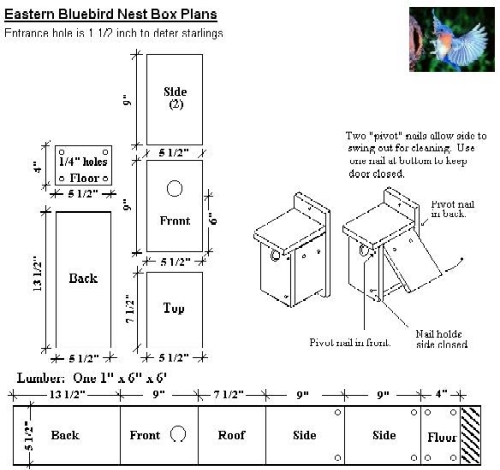Here are my basic plans. 
Here are the advanded plans. It helps to have a
Miter Saw.
HOW
TO MOUNT YOUR BLUEBIRD BOXES
Bluebird boxes can be mounted on poles, fence posts, utility poles or trees. Posts or poles are the best for providing protection from predators. You can purchase commercially available posts from your local hardware store or use existing fence posts or utility poles. If you use a fence post, be sure to mount the box where livestock can't get to it. When possible, face the boxes toward the next fence post so that the birds can look into the entrance hole from a perch. Mounting on trees is less desirable because of the threat of climbing predators like cats, raccoons, snakes and squirrels. The bottom of the nest box should be at least 3 feet above ground. Ideally, it should be mounted 4 to 5 feet above ground. There is no single compass direction that the bluebirds prefer to have the box facing. Your main objective should be to deter climbing predators, but allow for easy monitoring. Face the boxes away from prevailing winds. In hot climates, face them to the north or east to avoid direct midday sun. The most important aspect of mounting is to face the box toward some tree or shrub within 100 feet. When the young leave the nest they will make an initial flight to safety. WHERE IS THE BEST PLACE TO MOUNT BLUEBIRD BOXES? Whatever you do, make sure you place your nest boxes in good bluebird habitat. Not even the best bluebird house will attract bluebirds if it is in the wrong place. Here are some guidelines to follow for good bluebird habitat: Bluebirds
nest primarily in suburban and rural areas. During
breeding, bluebirds hunt insects by scanning the ground
from a perch, spotting an insect, then swooping down to
the ground to get it. Scattered young trees or shrubs, fence
posts and lower branches of a lone mature tree make good
hunting perches.
PROPER MAINTENANCE OF YOUR BLUEBIRD HOUSES
Please clean your bluebird houses after each brood has left. Remove and throw away any old nesting material and scrub with a 10% bleach solution. Old nesting material left on the ground could invite predators. Let dry completely before remounting. This will prevent parasites or diseases from spreading. WHEN SHOULD I PUT UP MY BLUEBIRD HOUSES? Anytime and as soon as possible! Bluebirds start looking for breeding nest boxes in February in the South and by mid March in the North. Bluebirds will use them well into August, producing 2-3 broods per year. Consider leaving your bluebird boxes up all year. When the mating season is over, birds will use the boxes as winter roosts. |
Materials/Tools
Needed:
1x6x8 Board
Srews or Nails
Saw
Screwdriver
Hammer
Stain (Optional)
Call Armistead
(804) 874-3294
CallArmistead.com
-
Business & Home Computer Services
-
Website Design
-
Networking
-
Business Automation
-
Spyware & Virus Removal
-
PC Tune-Ups
-
MS Access Programming
-
POS Systems
Bluebird House
Build a Bluebird house. Here’s a simple project that also makes a great Christmas gift and has other benefits too! First, you can’t have too many Bluebird houses, so they always make an excellent gift. They are inexpensive and simple to build. It’s a great project to do with your kids. You don’t need a lot of special tools. The bluebirds always appreciate a new home. Plans are easy to find online. I have provided some plans on my website: www.CallArmistead.com Click on the link at the bottom of the webpage. My plans use a 1”x6”x8’ and a handful of screws or nails and can be assembled in less than an hour. The tools needed are: A saw, drill, hammer and a screwdriver. Once finished, you can stain the house if you want. Here are some tips. Use screws and pre-drill the holes to keep the woods from splitting. Use a different style screw or nail to indicate the one needed to be removed to open the side access door. Get a few different stain colors for variety. Stone speckle stray paint makes a neat roof material. Rough up the inside area below the hole, so the baby birds have something they can grab on to. If you are giving the bluebird house as a gift include instructions on how and where to place the house. If you need to have your wood cut, take your 1x6x8 to the Country Courier’s office and I will cut it for you. I can be reached at 874-3294 if you have any questions.
![]()